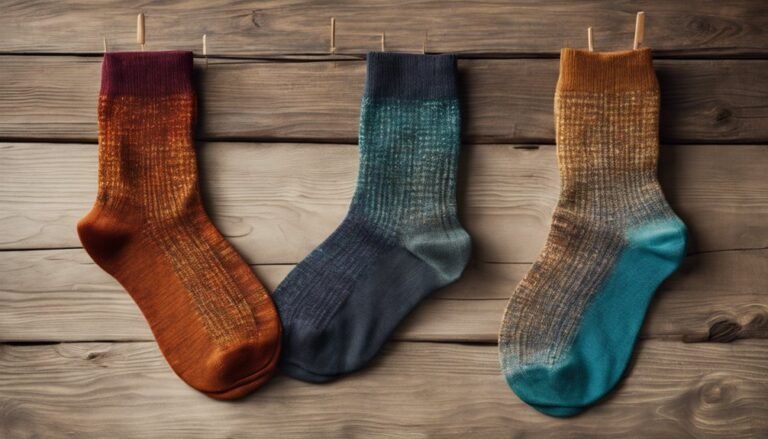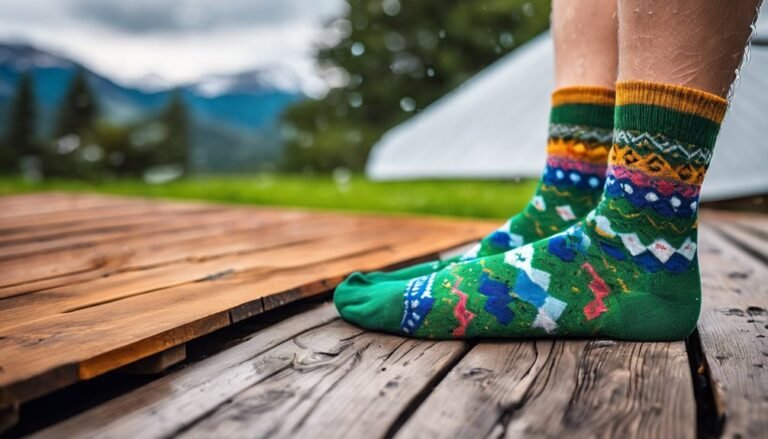Fluffy Socks vs. Thermal Socks: Which Provides More Warmth?
When comparing warmth, thermal socks clearly outperform fluffy socks. Thermal socks utilize advanced insulating materials that effectively trap air and retain heat, essential for cold weather activities. In contrast, fluffy socks prioritize comfort but often lack the insulation needed for outdoor adventures. Their cozy feel may be perfect for lounging, but if you're seeking warmth in harsh conditions, thermal socks offer superior performance. Discover more about how each type serves distinct purposes and when to choose them.
Understanding Fluffy Socks: Materials and Comfort

When it comes to cozying up on a chilly evening, fluffy socks are often the go-to choice for many. These socks, typically made from materials like polyester, cotton, or wool blends, offer several fluffy sock benefits that enhance your comfort levels. The plush texture provides a soft barrier against the cold, which can greatly improve your overall warmth perception. Furthermore, the breathable nature of these materials helps regulate moisture, ensuring your feet stay dry and comfortable. The cushioned design also aids in reducing foot fatigue, allowing for extended wear without discomfort. When choosing fluffy socks, consider the material composition to maximize both comfort and durability, ultimately enhancing your cozy experience during those colder nights.
The Science Behind Thermal Socks: Insulation Technology
When considering thermal socks, the material composition plays an essential role in their insulation capabilities. These socks often utilize synthetic fibers designed to trap air, creating an effective barrier against cold temperatures. Understanding how these materials work together can help you make informed choices about your cold-weather gear.
Material Composition Benefits
Understanding the material composition of thermal socks reveals their superior insulation technology. The blend of specific material types contributes greatly to comfort levels and heat retention.
Here's a breakdown of common materials used in thermal socks:
| Material Type | Insulation Properties | Comfort Level |
|---|---|---|
| Merino Wool | Excellent moisture-wicking | Soft and breathable |
| Synthetic Fibers | Lightweight and durable | Flexible and warm |
| Bamboo | Natural insulation | Soft and eco-friendly |
Each of these materials serves a unique purpose, ensuring that thermal socks not only trap heat effectively but also provide an enjoyable wearing experience. By understanding these components, you can make an informed choice for ideal warmth and comfort during cold weather.
Air Trapping Mechanism
The effectiveness of thermal socks largely hinges on their air trapping mechanism, which plays an essential role in insulation technology. This mechanism is designed to create a cushion of air around your feet, enhancing heat retention while minimizing heat loss. Unlike fluffy socks, thermal socks utilize materials that optimize air circulation, ensuring that warm air stays close to your skin. The trapped air acts as an insulating barrier, preventing cold air from penetrating and disrupting your body heat. By carefully balancing breathability and insulation, thermal socks deliver superior warmth without causing overheating. This intelligent design allows you the freedom to enjoy outdoor activities in colder conditions, knowing your feet will remain cozy and protected from the elements.
Comparing Warmth: Fluffy Socks vs. Thermal Socks
When evaluating warmth, it's essential to take into account the material composition of fluffy and thermal socks. Fluffy socks often utilize soft, synthetic fibers that prioritize comfort but may lack effective insulation, while thermal socks are designed with advanced materials that enhance both insulation and breathability. Understanding these differences can help you choose the best option for your needs.
Material Composition Differences
Material composition plays an essential role in determining the warmth and comfort of socks, particularly when comparing fluffy socks to thermal socks. Fluffy socks typically use synthetic fibers, like polyester or acrylic, designed for softness and a cozy feel. These sock fibers provide a plush texture that contributes to warmth retention but may not be as effective in extreme conditions. On the other hand, thermal socks often incorporate advanced materials, such as merino wool or specialized insulating blends, which enhance warmth retention even in colder environments. The structure of these fibers traps heat more efficiently, making thermal socks an ideal choice for frigid temperatures. Ultimately, understanding these material differences can help you choose the right sock for your needs.
Insulation and Breathability Factors
While both fluffy socks and thermal socks aim to provide warmth, their insulation and breathability characteristics differ considerably. Fluffy socks typically utilize soft, plush materials that offer decent insulation properties but may compromise breathability levels. This can lead to moisture accumulation, making your feet feel clammy. In contrast, thermal socks often incorporate advanced synthetic fibers that are designed to trap heat while allowing moisture to escape, enhancing overall comfort. The insulation properties of thermal socks are generally superior, keeping your feet warmer in colder conditions without sacrificing breathability. Consequently, if you're looking for a balance between warmth and moisture control, thermal socks may be the better choice, particularly in environments where temperature fluctuations are common.
The Best Activities for Fluffy Socks
Fluffy socks are perfect for a variety of cozy activities that enhance comfort and warmth. When you slip into these soft wonders, you're ready for some delightful experiences. Consider these top activities:
- Cozy indoor lounging: Fluffy socks make your relaxation time even better, keeping your feet toasty as you unwind.
- Winter movie marathons: Whether it's classic films or binge-watching the latest series, fluffy socks add a layer of comfort, letting you focus on the screen.
- Reading by the fire: There's nothing like curling up with a book, and fluffy socks guarantee your feet stay warm while you lose yourself in a good story.
Each of these activities enhances your sense of freedom, allowing you to enjoy winter's comforts without compromise.
The Best Activities for Thermal Socks
When it comes to braving the cold outdoors, thermal socks are your go-to choice, providing essential insulation and moisture-wicking properties. For activities like hiking trails, these socks guarantee your feet stay warm and dry, allowing you to traverse rugged terrain without discomfort. The advanced materials used in thermal socks help regulate temperature, preventing overheating during high-energy exertion.
Additionally, if you're engaging in winter sports such as skiing or snowboarding, thermal socks offer the cushioning and support needed for long hours on the slopes. They fit snugly in your boots, maximizing heat retention while minimizing the risk of blisters. Ultimately, thermal socks are indispensable for anyone looking to enjoy outdoor adventures in cold weather conditions.
Making the Right Choice: When to Wear Each Type

Choosing the right socks for specific situations can greatly impact your comfort and performance. Understanding when to wear fluffy socks versus thermal socks can enhance your experience in various settings. Consider the following:
- Fluffy Occasions: Wear fluffy socks when you're relaxing at home or enjoying a cozy night in. Their softness provides comfort without overheating.
- Thermal Environments: Opt for thermal socks during outdoor activities in cold climates, like hiking or skiing, where insulation is crucial to keep your feet warm and dry.
- Transitional Scenarios: In milder conditions, you might choose a combination, wearing fluffy socks indoors and switching to thermal socks when venturing outside.
Frequently Asked Questions
Can Fluffy Socks Be Worn Outside in Cold Weather?
When you step outside, envision fluffy socks enveloping your feet in cozy warmth. However, they lack the cold protection of specialized outdoor gear. For true outdoor comfort, consider thermal options designed for frigid conditions instead.
Are Thermal Socks Machine Washable?
Yes, most thermal socks are machine washable. However, always check the washing instructions specific to the thermal sock materials used. Following these guidelines guarantees your socks maintain their warmth and durability for longer periods.
How Long Do Fluffy Socks Typically Last?
Fluffy socks typically last around six months to a year, depending on sock durability and material quality. Higher-quality materials generally offer better performance, ensuring you enjoy their softness without frequent replacements in your wardrobe.
Do Thermal Socks Come in Different Thicknesses?
Yes, thermal socks do come in various thicknesses, allowing for a thickness comparison based on sock materials. Thicker options often provide better insulation, while thinner styles might offer more breathability, catering to your comfort preferences.
Can I Wear Both Types of Socks Together?
Sure, you can layer both sock types, but isn't that a cozy contradiction? Exploring sock materials reveals that layering enhances insulation, yet may limit breathability. Balance warmth and comfort to truly enjoy your freedom in footwear.







